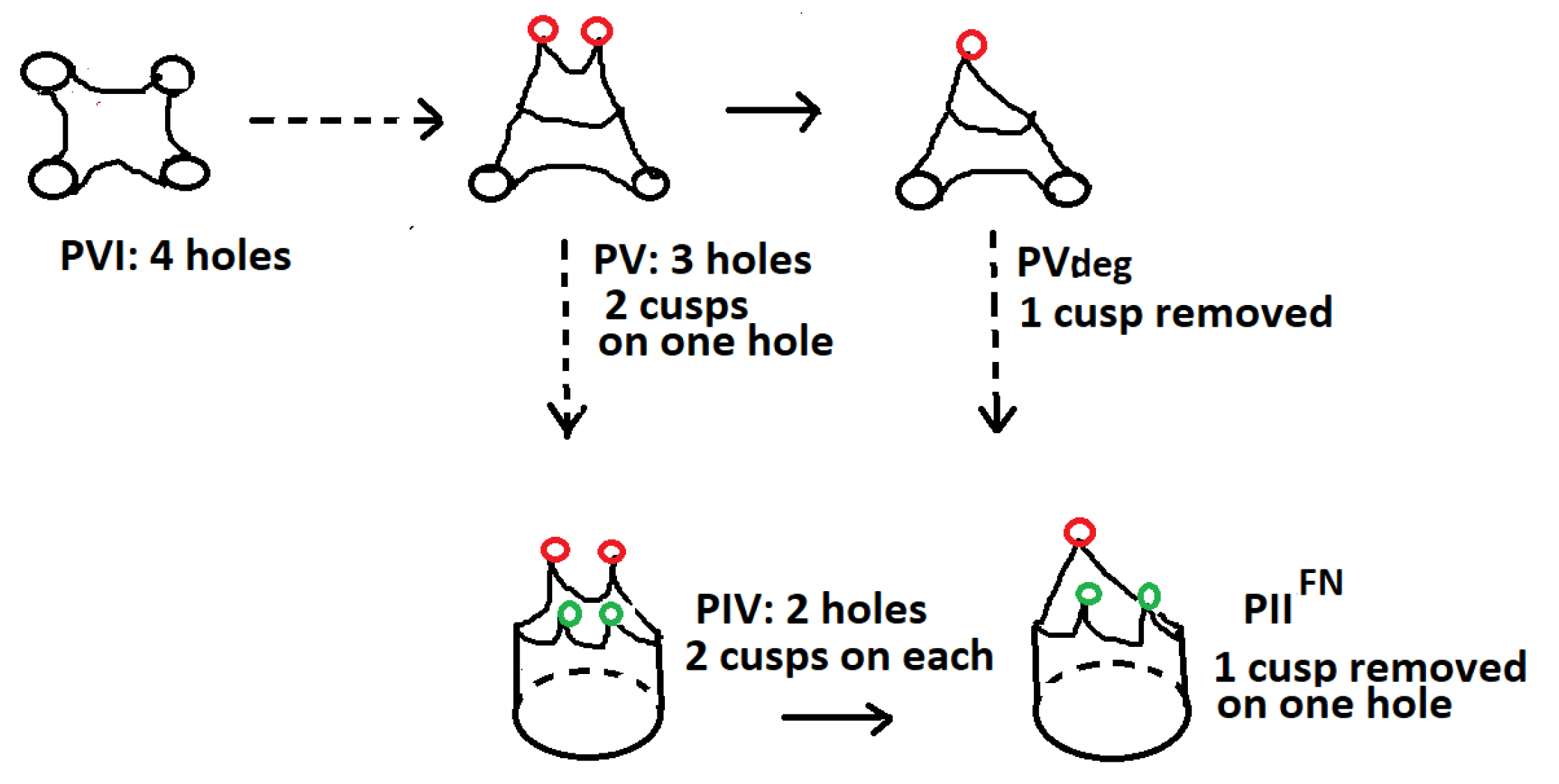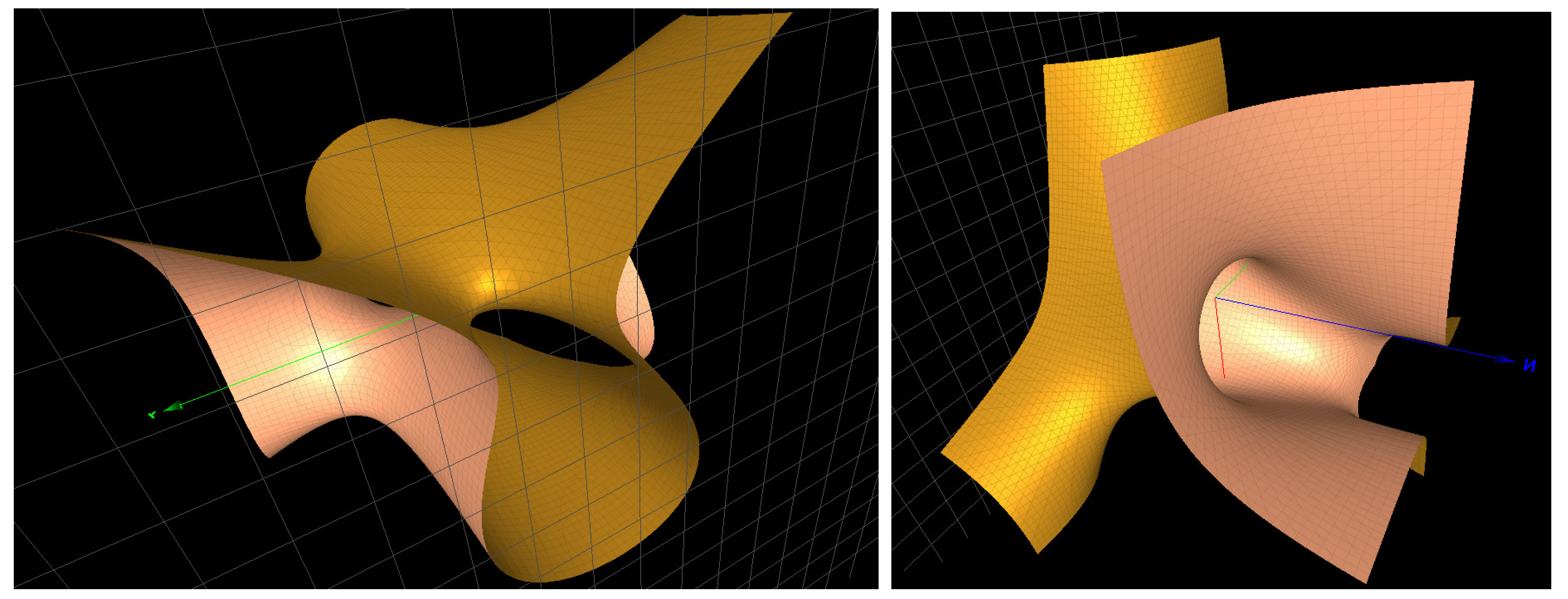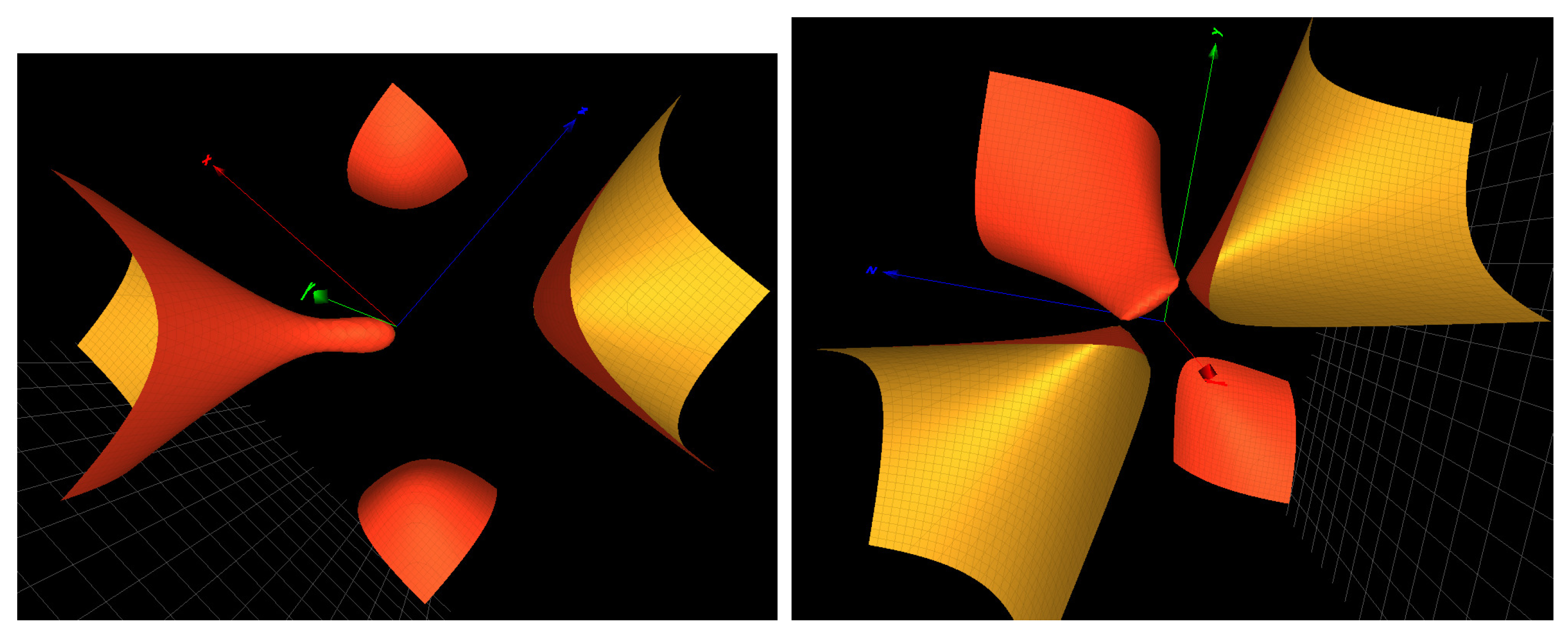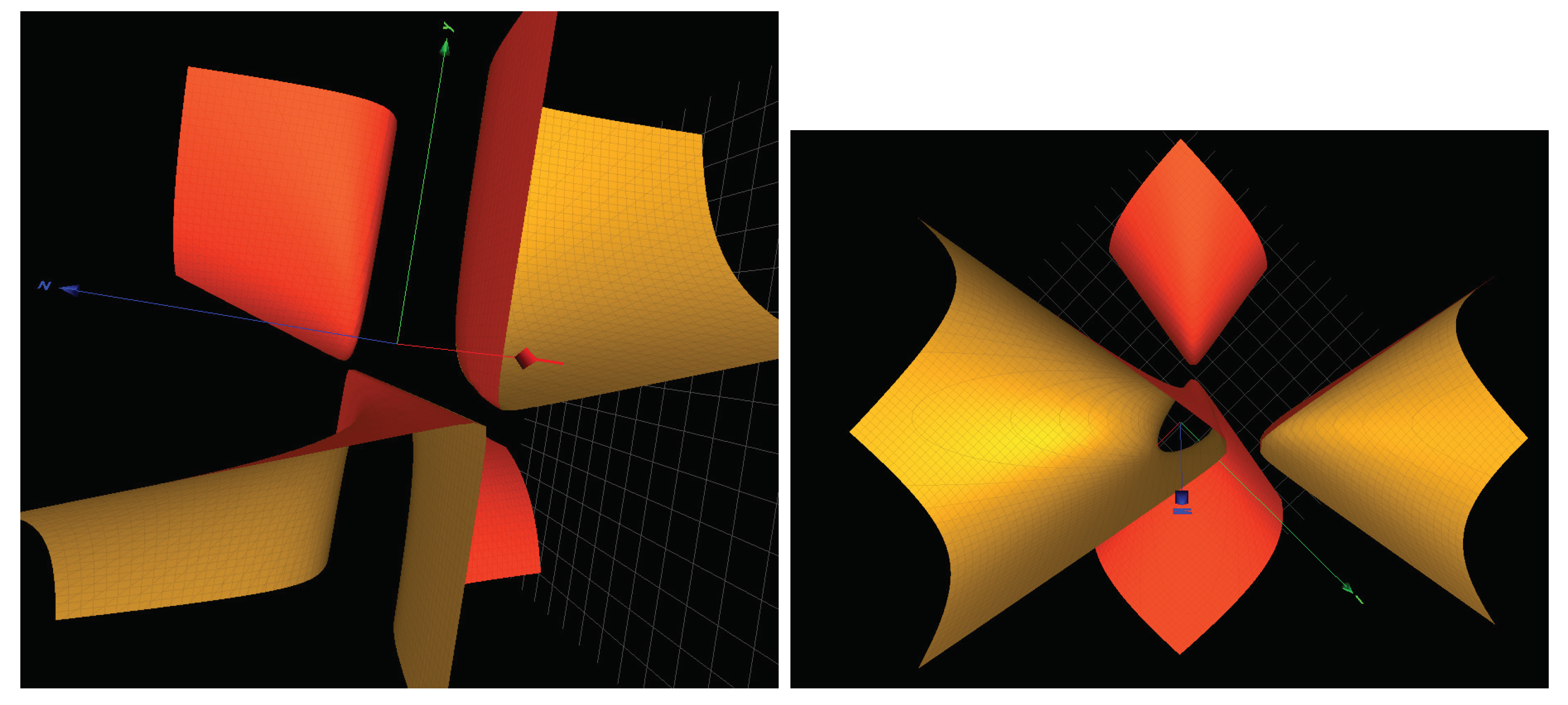Submitted:
27 March 2024
Posted:
28 March 2024
You are already at the latest version
Abstract
Keywords:
1. Introduction
2. Materials an Methods
2.1. Painlevé Equations and THEIR associated Character Variety
The Painlevé-Jimbo-Fricke Cubics Attached to Painlevé Equations
2.2. The Character Variety Associated to a DNA/RNA Sequence
3. Results and Discussion
| ine oncomir | seed | card seq | sing type | Cancer type |
| ine miR-21-3p | aacacca | not | , | ubiqitous |
| miR-204-5p | ucccuuu | not | , | prostate |
| miR-126-5p | auuauua | liver | ||
| miR-1908-5p | ggcgggg | : PVI | ubiquitous | |
| miR-1908-3p | cggccgc | , | breast | |
| ine miR-155-3p | uccuaca | not | , | ubiquitous |
| miR-9-5p | cuuuggu | : PV, PVI | metastasis | |
| miR-146b-3p | cccugug | not | }: PV | pancreatic |
| miR-19a-5p | guuuugc | , , PVI | pancreatic | |
| miR-181a-5p | acaucaa | , | ubiquitous | |
| miR-15-5p | agcagca | : PV | prostate | |
| miR-569 | guuaaug | not F2 | lung, breast | |
| miR-133b | uuggucc | not | , , | ubiquitous |
| miR-1270 | uggagau | osteosarcoma ine |
| ine tumor suppressor | seed | card seq | sing type | Cancer type |
| ine miR-let-7a-5p | gagguag | , | ubiquitous | |
| miR-let-7a-3p | uauacaa | no cubic | ubiquitous | |
| miR-34b-3p | aaucacu | not | , , | lung, breast |
| miR-200a-5p | aucuuac | not | , | skin, colorectal |
| miR-22-5p | guucuuc | nsc lung | ||
| miR-214-5p | gccugu | ubiquitous | ||
| . | gccuguc | no cubic | . | |
| miR-214-3p | cagcag | . | ||
| . | cagcagg | no cubic | . | |
| ine miR-503-5p | agcagcg | rational scroll | colon | |
| miR-141-5p | aucuucc | no cubic | blood leukemia | |
| miR-31-5p | ggcaaga | rational scroll | oral | |
| miR-122-5p | gagugug | no cubic | ubiquitous | |
| miR-29b-5p | cugguuu | no isol. sing. | head, neck | |
| miR-143-3p | gagauga | no cubic | pancreatic | |
| miR-140-5p | agugguu | no isol. sing. | colorectal | |
| miR-340-5p | uauaaag | no cubic | ubiquitous | |
| miR-340-3p | cguucuc | no cubic | ubiquitous | |
| miR-27-5p | cugucug | no isol sing. | Wilms’ tumor | |
| miR-27-3p | acagcaa | no cubic | cervical ine |
3.1. Human microRNAs That Mainly Act as Oncomirs
The Oncomir miR-21-3p
The Oncomir miR-204-5p
The Oncomir miR-126b-5p
The Oncomir mir-1908
The Oncomir miR-155-3p
The Oncomir miR-9-5p
The Oncomir miR-146b-3p
The Oncomir miR-19a-5p
The Oncomir miR-181a-5p
The Oncomir miR-15-5p
The Oncomir miR-569
The Oncomir miR-133b
The Oncomir miR-1270b
3.2. Human microRNAs That Mainly Act as Tumor Suppressors
MicroRNA let-7a-5p
MicroRNA 34b-3p
MicroRNA 200a-5p
MicroRNA 22-5p
MicroRNA 214
MiRNA 503-5p
MicroRNA 141-5p
MicroRNA 31-5p
MicroRNA 122-5p
MicroRNA 29b-5p
MicroRNA 143-3p
MicroRNA 140-5p
3.3. MicroRNA 340
3.4. MicroRNA 27
4. Conclusions
Author Contributions
Funding
Informed Consent Statement
Data Availability Statement
Acknowledgments
Conflicts of Interest
References
- Bernard, C. Lectures on the phenomena common to animals and plants 1974. Charles C Thomas Pub Ltd.: Springfield, IL, USA, 1974.
- Gene Expresssion. Available online: https://en.wikipedia.org/wiki/Gene_expression (accessed on 1 January 2023).
- Hyde, J.S. Genetic homeostasis and behavior: analysis, data, and theory. Behavior Genetics 1973, 3, 233–245. [Google Scholar] [CrossRef] [PubMed]
- Cowley, A.W., Jr. Genomics and homeostasis. Am. J. Physiol. Regul. Integr. Comp. Physiol. 2002, 2, 611–27. [Google Scholar] [CrossRef] [PubMed]
- Manohar, S.; Estrada, M.E.; Uliana, F.; Vuina, K.; Alvarez, P.M.; de Bruin, R.A.M.; Neurohr, G.E. Genome homeostasis defects drive enlarged cells into senesescence. Molec. Cell 2023, 8, 4032–4046. [Google Scholar] [CrossRef]
- Planat, M.; Amaral, M.M.; Irwin, K. Algebraic morphology of DNA–RNA transcription and regulation. Symmetry 2023, 15, 770. [Google Scholar] [CrossRef]
- Planat, M.; Amaral, M.M.; Fang, F.; Chester, D.; Aschheim, R.; Irwin, K. DNA sequence and structure under the prism of group theory and algebraic surfaces. Int. J. Mol. Sci. 2022, 3, 13290. [Google Scholar] [CrossRef] [PubMed]
- Planat, M.; Amaral, M.; Chester, D.; Fang, F.; Aschheim, R.; Irwin, K. Group theory of messenger RNA metabolism and disease. Gene Expression 2024. [Google Scholar] [CrossRef]
- Schrödinger, E. What Is Life? The Physical Aspect of the Living Cell; Cambridge University Press: Cambridge, UK, 1944. [Google Scholar]
- Planat, M.; Chester, D.; Irwin, K. Dynamics of Fricke-Painlevé VI surfaces. Dynamics 2024, 4, 1–13. [Google Scholar] [CrossRef]
- Lisovyy, O.; Tykhyy, Y. Algebraic solutions of the sixth Painlevé equation. J. Geom. Phys.
- Klimeš, M. Wild monodromy of the fifth Painlevé equation and its action on the wild character variety: approach of confluence. arXiv 2021, arXiv:math.CA /1609.05185. [Google Scholar] [CrossRef]
- Paul, E.; Ramis, J.P. Dynamics of the fifth Painlevé foliation. arXiv 2023, arXiv:math.DS /2301.08597. [Google Scholar]
- Clarkson, P.A.; Joshi, N.; Mazzocco, M.; Nijhoff, F.W.; Noumi, M. One hundred years of PVI, the Fuchs–Painlevé equation. J. Phys. A: Math. Gen. 2006, 39, EO1. [Google Scholar] [CrossRef]
- Isomonodromic Deformation. Available online: https://en.wikipedia.org/wiki/Isomonodromic_deformation (accessed on 1 August 2023).
- Boalch, P. From Klein to Painlevé via Fourier, Laplace and Jimbo. Proc. Lond. Math. Soc. 2005, 90, 167–208. [Google Scholar] [CrossRef]
- Cantat, S. Bers and Hénon, Painlevé and Schrödinger. Duke Math. J. 2009, 149, 411–460. [Google Scholar] [CrossRef]
- Jimbo, M.; Miwa, T. Monodromy preserving deformation of linear ordinary differential equations with rational coefficients. II. Physica 1981, 2D, 407–448. [Google Scholar]
- Chekhov, L.; Mazzocco, M.; Rubtsov, V. Painlevé monodromy manifolds, decrated character varieties and cluster algebras. Int. Math. Res. Not. 2017, 24, 7639–7691. [Google Scholar]
- Van Der Put, M.; Saito, M.H. Moduli spaces for linear differential equations and Painlevé equations. Ann. Inst. Fourier 2009, 59, 2611–2667. [Google Scholar] [CrossRef]
- Goldman, W.M. Trace coordinates on Fricke spaces of some simple hyperbolic surfaces. In Handbook of Teichmüller theory, Eur. Math. Soc. , Zürich, 2009, 13, 611–684. [Google Scholar]
- Ashley, C.; Burelle, J.P.; Lawton, S. Rank 1 character varieties of finitely presented groups. Geom. Dedicata 2018, 192, 1–19. [Google Scholar] [CrossRef]
- Markopoulos, G.S.; Roupakia, E.; Tokamani, M.; Chavdoula, E.; Hatziapostolou, M.; Polytarchou, C.; Marcu, K.B.; Papavassiliou, A.G. Sandaltzopoulos, R.; Kolettas, E. A step-by-step microRNA guide to cancer development and metastasis. Cell Oncol. 2017, 40, 303–339. [Google Scholar] [CrossRef] [PubMed]
- Lei, X.; Mudiyanselage, T.B.; Zhang, Y.; Bian, C.; Lan, W.; Yu, N.; Pan, Y. A comprehensive survey on computational methods of non-coding RNA and disease association prediction. Briefings in Bioinformatics 2021, 22, 1–31. [Google Scholar] [CrossRef]
- Xie, B.; Ding, Q.; Han, H.; Wu, D. miRCancer: a microRNA-cancer association database constructed by text mining on literature. Bioinformatics 2013, 29, 638–644. [Google Scholar] [CrossRef]
- Kozomara, A.; Birgaonu, M.; Griffiths-Jones, S. miRBase: from microRNA sequences to function. Nucl. Acids Res. 2019, 47, D155–D162. [Google Scholar] [CrossRef]
- miRBase: the microRNA database. Available online: https://www.mirbase.org/ (accessed on 1 November 2022).
- Hashemi, M.; Mirdamadi, M.S.A.; Talebi, Y.; Khaniabad, N.; Banaei, G.; Daneii, P.; Gholami, S.; Ghorbani, A.; Tavakolpournegari, A.; Farsani, Z.M.; Zarrabi, ANabavi, N. ; Z.; ieh, M.A.; Rashidi, MTaheriazam, A.; Entezari, M.; Khan, H. Pre-clinical and clinical importance of miR-21 in human cancers: umorigenesis, therapy response, delivery approaches and targeting agents. Pharm. Res. 2023, 187, 106568. [Google Scholar] [CrossRef] [PubMed]
- Li, T.; Pan, H.; Li, R. The dual regulatory role of miR-204 in cancer. Tumor Biol. 2016, 37, 11667–11677. [Google Scholar] [CrossRef]
- Yang, F.; Bian, Z.; Xu, P.; Sun, S.; Huang, Z. MicroRNA-204-5p: a pivotal tumor suppressor. Cancer Medicine 2023, 12, 3185–3200. [Google Scholar] [CrossRef] [PubMed]
- Ai, Y.; Luo, S.; Wang, B.; Xiao, S.; Wang, Y. miR-126-5p promotes tumor cell proliferation, metastasis and invasion by targeting TDO2 in hepatocellular carcinoma. Molecules 2022, 27, 443. [Google Scholar] [CrossRef] [PubMed]
- Shen, J.; Wu, Y.; Ruan, W.; Zhu, F.; Duan, S. miR-1908 Dysregulation in human cancers. Front. Oncol. 2022, 12, 857743. [Google Scholar] [CrossRef] [PubMed]
- Zhu, Y.; Wang, Q.; Xia, Y.; Xiong, X.; Weng, S.; Ni, H.; Ye, Y.; Chen, L.; Lin, J.; Chen, Y.; Niu, H.; Chen, X.; Lin, Y. Evaluation of miR-1908-3p as a novel serum biomarker for breast cancer and analysis its oncogenic function and target genes. BMC Cancer 2020, 20, 644. [Google Scholar] [CrossRef] [PubMed]
- Ghafouri-Fard, S.; Khoshbakht, T.; Husse, B.M.; Thaheri, M.; Samsami, M. miR-1908: a microRNA with diverse functions in cancers and non-malignant conditions. Cancer Cell Int. 2022, 22, 281. [Google Scholar] [CrossRef]
- Dawson, O.; Piccinini, A.M. miR-155-3p: processing by-product or rising star in immunity and cancer? Open Biol. 2022, 12, 220070. [Google Scholar] [CrossRef]
- Liu, Y.; Zhao, Q.; Xi, T.; Zheng, L.; Li, X. MicroRNA-9 as a paradoxical but critical regulator of cancer metastasis: Implications in personalized medicine. Genes & Diseases 2021, 8, 759–768. [Google Scholar]
- Zhou, M.; Gao, Y.; Wang, M.; Guo, X.; Li, X.; Zhu, F.; Xu, S.; Qin, R. miR-146b-3p regulates proliferation of pancreatic cancer cells with stem cell-like properties by targeting MAP3K10. J. of Cancer 2021, 12, 3726–3740. [Google Scholar] [CrossRef] [PubMed]
- Ardizzone, A.; Calabrese, G.; Campolo, M.; Filippone, A.; Giuffrida, D.; Esposito, F.; Colarossi, C.; Cuzzocrea, S.; Esposito, E; Paterniti, I. Role of miRNA-19a in Cancer Diagnosis and Poor Prognosis. Int. J. Mol. Sci. 2021, 22, 4697. [Google Scholar] [CrossRef]
- Li, J.; Shen, J.; Zhao, Y.; Du, F.; Li, M.; Wu, X.; Chen, Y.; Wang, S.; Xiao, Z.; Wu, Z. V. Role of miR-81a-5p in cancer (Review). Int. J. Oncol. 2023, 63, 108. [Google Scholar] [CrossRef]
- Ghafouri-Fard, S.; Khoshbakht, T.; Hussen, B.M.; Jamal, H.H.; Taheri, M.; Hajiesmaeili, M. A comprehensive review on function of miR-15b-5p in malignant and non-malignant Disorders. Front. Oncol. 2022, 12, 870996. [Google Scholar] [CrossRef] [PubMed]
- Zheng, Y.P.; Wu, L.; Gao, J.; Wang, Y. Tumor suppressive role of miR-569 in lung cancer. Oncol. Lett. 2018, 15, 4087–4092. [Google Scholar] [CrossRef] [PubMed]
- Li, D.; Xia, L.; Chen, M.; Lin, C.; Wu, H.; Zhang, Y.; Pan, S.; Li, X. miR-133b, a particular member of myomiRs, coming into playing its unique pathological role in human cancer. Oncotarget 2017, 8, 50193–50208. [Google Scholar] [CrossRef] [PubMed]
- Liu, Y.; Guo, W.; Fang, S.; He, B.; Li, X.; Fan, L. miR-1270 enhances the proliferation, migration, and invasion of osteosarcoma via targeting cingulin. Eur. J. Histochem. 2021, 65, 3237. [Google Scholar] [CrossRef] [PubMed]
- Shew, M.; Wichova, H.; Peter, M.S.; Warnecke, A.; Staecker, H. Distinct microRNA profiles in the perilymph and serum of patients with Menière’s disease. Front. Neur. 2021, 12, 646928. [Google Scholar] [CrossRef] [PubMed]
- Yazarlou, F.; Kadkhoda, S.; Ghafouri-Fard, S. Emerging role of let-7 family in the pathogenesis of hematological malignancies. Biomed. & Pharmac. 2021, 144, 112334. [Google Scholar]
- Ma, Y.; Snen, N.; Wicha, M.S.; Luo, M. The Roles of the Let-7 Family of MicroRNAs in the Regulation of Cancer Stemness. Cells 2021, 10, 2415. [Google Scholar] [CrossRef]
- Liu, J.K.; Liu, H.F.; Ding, Y.; Gao, G.D. Predictive value of microRNA let-7a expression for efficacy and prognosis of radiotherapy in patients with lung cancer brain metastasis. Medicine (Baltimore) 2018, 97, e12847. [Google Scholar] [CrossRef] [PubMed]
- Feng, H.; Ge, F.; Du, L.; Zhang, Z.; Liu, D. miR-34b-3p represses cell proliferation, cell cycle progression and cell apoptosis in non-small-cell lung cancer (NSCLC) by targeting CDK4. J. Cell Mol. Med. 2019, 23, 5282–5291. [Google Scholar] [CrossRef] [PubMed]
- Aravindan, N.; Subramanian, K.; Somasundaran, D.B.; Herman, T.S.; Aravindan, S. MicroRNAs in neuroblastoma tumorigenesis, therapy resistance, and disease evolution. Cancer Drug Resist 2019, 2, 1086. [Google Scholar] [CrossRef] [PubMed]
- Lazaridou, M.F.; Gonschorek, E.; Massa, C.; Friedrich, M.; H. ; ke, D.; Mueller, A.; Jasinski-Bergner, S.; Dummer, R.; Koelblinger, P.; Seliger, B. Identification of miR-200a-5p targeting the peptide transporter TAP1 and its association with the clinical outcome of melanoma patients. Oncoimmunology 2020, 9, 1774323. [Google Scholar] [CrossRef] [PubMed]
- Carter, J.V.; O’Brien, S.J.; Burton, J.F.; Oxford, B.G.; Stephen, V.; Hallion, J.; Bishop, C.; Galbraith, N.J.; Eichenberger, M.R.; Sarojini, H.; Hattab, E.; Gal, iuk, S. The microRNA-200 family acts as an oncogene in colorectal cancer by inhibiting the tumor suppressor RASSF2. Oncol. Lett. 2019, 18, 3994–4007. [Google Scholar] [CrossRef] [PubMed]
- Diaz-Riascos, Z.V.; Ginesta, M.M.; Fabrejat, J.; Buscai, L.; Cordelier, P.; Capellá, G. Expression and role of microRNAs from the miR-200 Family in the tumor formation and metastatic propensity of pancreatic cancer. Mol. Ther. Nucleic Acids 2019, 17, 491–503. [Google Scholar] [CrossRef] [PubMed]
- Han, X.; Li, H.; Liu, S.; Ehao, Z. Study on the potential mechanism of miR-22-5p in non-small-cell lung cancer. Dis. Markers 2022, Sep. 6, 3750734. [Google Scholar] [CrossRef]
- Zhao, H.; Chen, C.; Song, H.; Qin, R.; Wang, X.; He, Q.; Li, F.; Zhao, H.; Li, Y. DNA topoisomerase II-α regulated by miR-22-5p promotes hepatocellular carcinoma invasion and migration through the hippo pathway. Oxid Med. Cell LongeV 2022, Oct. 17, 4277254. [Google Scholar] [CrossRef]
- Fromm, B.; Billipp, T.; Peck, L.E.; Johansen, M.; Tarver, J.E.; King, B.L.; Newcomb, J.M.; Sempere, L.F.; Flatmark, K.; Hovig, E.; Peterson, K.J. A uniform system for the annotation of human microRNA genes and the evolution of the human microRNAome. Annu. Rev. Genet. 2015, 23, 213–242. [Google Scholar] [CrossRef]
- Amin, M.M.J.; Trevelyan, C.J.; Tyurner, N.A. MicroRNA-214 in health and disease. Cells 2021, 23, 3274. [Google Scholar] [CrossRef]
- Planat, M.; Amaral, M.M.; Chester, D.; Irwin, K. SL(2,C) scheme processsing of singularities in quantum computing and genetics. Axioms 2023, 12, 233. [Google Scholar] [CrossRef]
- He, Y.; Cai, Y.; Pai, P.M.; Ren, X.; Xia, Z. The causes and consequences of miR-503 dysregulation and its impact on cardiovascular disease and cancer. Front. Pharmacol. 2021, 12, 629611. [Google Scholar] [CrossRef] [PubMed]
- Wei, L.; Sun, C.; Zhang, Y.; Han, N.; Sun, S. miR-503-5p inhibits colon cancer tumorigenesis, angiogenesis, and lymphangiogenesis by directly downregulating VEGF-A. Gene Ther. 2022, 1–2, 28–40. [Google Scholar] [CrossRef] [PubMed]
- Bao, J.; Li, X.; Li, Y.; Huang, C.; Meng, X.; Li, J. MicroRNA-141-5p acts as a tumor suppressor via targeting RAB32 in chronic myeloid leukemia. Front. Pharmac. 2019, 10, 1545. [Google Scholar] [CrossRef] [PubMed]
- Schmittgen, T.D. mir-31: a master regulator of matastasis? Future Oncol.y 2009, 6, 17–20. [Google Scholar] [CrossRef] [PubMed]
- Lu, Z.; He, Q.; Liang, J.; Li, W.; Su, Q.; Chen, Z.; Wan, Q.; Zhou, X.; Cao, L.; Sun, J.; Wu, Y.; Liu, L.; Wu, X.; Hou, J.; Lian, K.; Wang, A. miR-31-5p is a potential circulating biomarker and therapeutic target for oral cancer. Mol. Ther. Nucleic Acids 2019, 16, 471–480. [Google Scholar] [CrossRef] [PubMed]
- Lashkarian, M.F.; Hashemipour, N.; Niaraki, N.; Soghala, S.; Moradi, A.; Sarhangi, S.; Hatami, M.; Aghaei-Zarch, F.; Khosravifar, M.; Mohhamadzadeh, A.; Najafi, S.; Majidpoor, J.; Farnia, P.; Aghaei-Zarch, S.M. MicroRNA-122 in human cancers: from mechanistic to clinical perspectives. Cancer Cell Int 2023, 23, 20. [Google Scholar] [CrossRef] [PubMed]
- Kurihara-Shimomura, M.; Sasahira, T.; Shimomura, H.; Nakashima, C.; Kirita, T. The oncogenic activity of miR-29b-1-5p induces the epithelial-mesenchymal transition in oral squamous cell carcinoma. J. Clin. Med. 2019, 8, 273. [Google Scholar] [CrossRef] [PubMed]
- Asghariazar, V.; Kadkhodayi, M.; Sarailoo, M.; Jolfayi, A.G.; Baradaran, B. MicroRNA-143 as a potential tumor suppressor in cancer: An insight into molecular targets and signaling pathways. Patho. Res. and Pract. 2023, 250, 154792. [Google Scholar] [CrossRef]
- Xie, F.; Li, C.; Zhang, X.; Peng, W.; Wen, T. miR-143-3p suppresses tumorigenesis in pancreatic ductal adenocarcinoma by targeting KRAS. Biomed. & Pharmac. 2019, 119. [Google Scholar]
- Zhao, Z.; Liu, W.; Li, J. miR-140-5p inhibits cell proliferation and invasion in colorectal carcinoma by targeting SOX4. Oncol. Lett. 2019, 17, 2215–2220. [Google Scholar] [CrossRef] [PubMed]
- Huang, Z.; Xu, Y.; Wan, M.; Zeng, X.; Wu, J. miR-340: A multifunctional role in human malignant diseases. Int. J. Biol. Sci. 2021, 17, 236–246. [Google Scholar] [CrossRef] [PubMed]
- Zhu, X.; Tian, G.; Quan, J.; He, P.; Liu, J. Effects of miR-340 overexpression and knockdown on the proliferation and metastasis of NSCLC cell lines. Int. J. Mol. Med. 2019, 44, 643–651. [Google Scholar] [CrossRef] [PubMed]
- Guo, Z.T.; Yu, Q.; Miao, C.; Ge, W.; Li, P. MicroRNA-27a-5p inhibits proliferation, migration, and invasion and promotes apoptosis of Wilms’ tumor cell by targeting PBOV1. Mol. Cell. Biog. 2022, 42, e0039721. [Google Scholar] [CrossRef] [PubMed]
- Li, M.; Gao, Z.; Wang, S. Zhao, Y.; Xie, H. miR-27a-3p upregulation by p65 facilitates cervical tumorigenesis by increasing TAB3 expression and is involved in the positive feedback loop of NF-kB signaling. Oncol. Rep. 2023, 50, 1791–2431. [Google Scholar] [CrossRef]
- Boalch, P. Topology of the Stokes phenomenon. Proc. Symp. Pure Math. 2021, 103.1, 01832. [Google Scholar]




Disclaimer/Publisher’s Note: The statements, opinions and data contained in all publications are solely those of the individual author(s) and contributor(s) and not of MDPI and/or the editor(s). MDPI and/or the editor(s) disclaim responsibility for any injury to people or property resulting from any ideas, methods, instructions or products referred to in the content. |
© 2024 by the authors. Licensee MDPI, Basel, Switzerland. This article is an open access article distributed under the terms and conditions of the Creative Commons Attribution (CC BY) license (http://creativecommons.org/licenses/by/4.0/).





